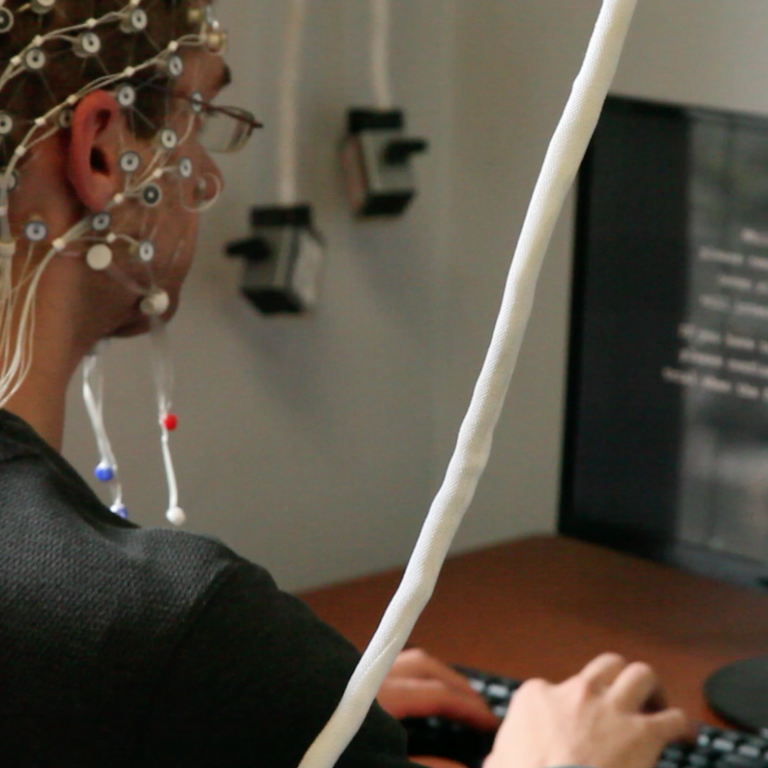Both light and sound travel as waves, with characteristics that allow people with typical vision and hearing to perceive and categorize them when they reach their eyes and ears: “That’s a small red dog barking,” someone might say.
But while people can easily name most colors in different groups—distinguishing the specific frequencies and wavelengths of light—few can do the same for musical notes, which represent sounds with distinct, unchanging pitches. Hearing a musical note and naming it is beyond the listening expertise of most people.
In fact, this ability is rare enough that society celebrates people who can label musical notes heard spontaneously: They are said to have “perfect pitch,” or “absolute pitch” as scientists who study the science of auditory perception call the ability. More common among musicians is “relative pitch,” the ability to name musical notes in relation to one another on a scale (“do, re, mi”) but not without a reference note.
For psychologists and neuroscientists at the University of Chicago who have studied perfect pitch for years, this raised an interesting question about the relationship between sensory processing and cognition: What makes some musicians so good at identifying musical sounds? Is it the way their brains process sounds, their musical training, or both?
To help answer this question, doctoral student Katherine Reis and Prof. Howard Nusbaum worked with other UChicago researchers to design a study comparing people with perfect pitch and people without perfect pitch on a series of tasks.
“The presumed rarity of absolute pitch should be striking, as it is comparable to only being able to classify colors by their relationship to other colors and not with consistent labels such as ‘blue,’” the authors wrote in a journal article describing their findings, which was published in July in Nature: Scientific Reports.
The task the researchers tested participants on required naming piano notes and naming “pure” sine tones generated by a computer (these represent exact frequencies without an instrument’s timbre).
Thirty-one people participated in the study: 16 with perfect pitch and 15 who were accomplished musicians without perfect pitch. In each trial, the scientists used electrodes attached non-invasively to people’s heads to monitor the way their brains and nervous systems reacted to sounds—a measure called the “frequency following response” (FFR)—and recorded their accuracy along with details about the participants’ backgrounds in music, including prior training.
They found that in both groups, the FFR—which provides a snapshot of the integrity of a person’s ability to process sounds—predicted people’s performance on pitch identification better than any metric previously used in studies of perfect pitch, including musical training.
Participants also tended to be better at naming notes played on a piano as compared to the computer-generated sine tones: Those with perfect pitch averaged 98% accuracy on piano and 77% for sine tones, while those without averaged 29% accuracy on piano and 25% for sine tones.
According to UChicago doctoral student John Veillette, who was also a co-author on the paper, this suggests that timbres—which are conferred by upper harmonics in sound frequencies and give instruments their unique, familiar rings—play an important role in pitch recognition. Reis said that implies that experience is probably involved in pitch recognition, since even people with self-reported perfect pitch weren’t “perfect” when the notes were produced in an unfamiliar way.
“As a result of our study, we now know that features of the FFR predict absolute pitch ability even better than the developmental factors that people usually associate with absolute pitch, like the age you first learned an instrument,” Reis said. “This suggests there’s a really low-level difference (in terms of the nervous system’s response) in how absolute pitch possessors encode sounds in the brain.”
But despite the differences between the brains of people with and without perfect pitch, FFR itself is not a “fixed” trait—in other words, people may be able to improve their FFR, and their ability to name notes, over time, according to the scientists.
So, the study demonstrates that FFR is a very strong predictor of a person’s accuracy when labeling notes, and perhaps a good metric for understanding a person’s facility with sound recognition. But while it suggests that people who have fast, accurate FFR may be better at such tasks, it doesn’t mean that FFR is immutable.
“As many fields in the behavioral sciences are now discovering, it may not be possible to fully understand cognition or perception without considering their dynamic interaction,” the authors wrote.
For Nusbaum, this was not surprising. The Stella M. Rowley Professor of Psychology has spent years studying perfect pitch alongside other scientists—including study co-authors Shannon Heald, an assistant instructional professor in the Department of Psychology, and Stephen Van Hedger, AB’09, PhD’15, now an assistant professor of psychology at Huron University College in Ontario.
They have argued consistently that perfect pitch is not a dichotomous ability that people either have or do not have: Instead, it may be better thought of as a continuous spectrum.
“Perfect pitch was long thought to be a rare ability that only some children could acquire if they had the right musical training in early childhood,” Nusbaum said. “However, this study provides further evidence that while the differences in people’s ability to categorize notes are real—and related to cognitive processing—our brains develop in tandem with the skills we practice over our entire lives. So, when it comes to pitch learning, practice, in a sense, really does make ‘perfect.’”
Citation: “Individual differences in human frequency-following response predict pitch labeling ability” Reis et al. Nature: Scientific Reports, July 12, 2021.





